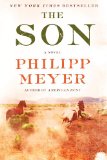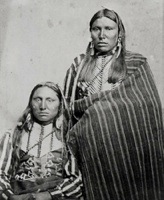Summary | Excerpt | Reviews | Beyond the Book | Read-Alikes | Genres & Themes | Author Bio

Critics' Opinion:
Readers' Opinion:
First Published:
May 2013, 576 pages
Paperback:
Jan 2014, 592 pages
 Book Reviewed by:
Book Reviewed by:
Kim Kovacs
Buy This Book
This article relates to The Son
One of the main characters in The Son is kidnapped by Comanches and lives as a member of the Kotsoteka tribe.
The word Comanche is thought to be a Spanish corruption of Kohmahts, the Ute term for enemy (the Ute and the Comanche conducted a sporadic 50 year war against each other during the middle of the 18th century). Those referred to as Comanches call themselves Numinu - "The People." Originally part of the eastern Shoshone nations (as evinced by their similar language and customs), their emergence as a distinct people occurred just before the turn of the 18th century and coincided with the introduction of the horse to the American Southwest around 1680 CE. The horse allowed the Comanche to expand their hunting grounds, and they became known as expert riders. The Comanche primarily occupied the Great Plains of Texas, Oklahoma and New Mexico at the time Europeans began to settle the area.
The Comanche nation was a loose collection of eight to twelve autonomous sub-nations further divided into smaller bands. While their government was not as rigidly organized as those of the other Great Plains tribes, they were quite democratic, choosing leaders by popular consent as the need arose. Each tribe had a war chief – in charge when the tribe was at war – and a peace chief (aka civil chief); the peace chief was generally more influential. Neither chief ruled by decree, however, with important decisions reached only by consensus of a tribal council (generally made up of the older respected men of the band). Tribal membership was fluid, and people often changed bands, particularly for purposes of marriage.
 The groups were nomadic, living a hunter-gatherer lifestyle and following the movements of the buffalo herds. Buffalo was their staple food, which were hunted by either driving them over a cliff or stalking them with bow and arrow. They also ate other game and supplemented their diet with wild roots, nuts and fruits, as well as whatever they were able to obtain by trading.
The groups were nomadic, living a hunter-gatherer lifestyle and following the movements of the buffalo herds. Buffalo was their staple food, which were hunted by either driving them over a cliff or stalking them with bow and arrow. They also ate other game and supplemented their diet with wild roots, nuts and fruits, as well as whatever they were able to obtain by trading.
In addition to being their main food source, buffalo were essential to the Comanche lifestyle. Buffalo hide provided clothing and shelter, its sinew was used for bowstrings and thread for sewing, its stomach provided a bag for carrying water, and its bones were used for tools and weapons; no part of the animal went to waste.
Comanche lived in tipis (also spelled teepees or tepes), a set of 16 to 18 lodge poles with a tanned buffalo hide stretched over them. The tipis belonged to the women of the tribe, who were responsible for moving the house when their band changed locations. The tipis were extremely portable - an entire village could be packed for moving in an hour. The women were also foragers, scouring the surrounding area for edibles, and were in charge of the children, cooking, preparing the hides and manufacturing/repairing clothes and their shelter.
In addition to hunting, the men of the Comanche nation were warriors and traders. Land ownership did not exist among the Great Plains tribes, and consequently war with others was generally because one tribe's honor was impugned by the other, conflict seldom lasted long and it was rarely a fight to the death. Comanches also traded with other tribes and with Europeans, particularly for horses. Theft was a large part of the trading, with Comanches frequently selling back items they had stolen, including selling kidnapped captives back to their relatives. They were considered one of the more educated tribes, and trading parties often included at least one individual who spoke Spanish and French as well as three or four other Native American languages.
The band about which we have the most documentation was the Penateka ("honey eaters"), the southernmost of the Comanches who occupied Texas during the Indian wars and are prominently mentioned in Texas history. The Nokoni ("Those Who Turn Back"), Tanima ("Liver-Eaters) and Tenawa ("Those Who Stay Downstream") lived in the middle range of the territory. In the north were the Kotsotekas ("Buffalo-Eaters") who were often found camped along the Canadian River in western Oklahoma, and the nothernmost band was the Yamparikas ("Yap-Eaters" – yap being an edible root).
The Comanche tribe was nearly wiped out in the middle of the 19th century by disease and by starvation after the Europeans slaughtered nearly all the buffalo in the Great Plains. They were also hunted by those who saw them as a barbarian threat to civilization. A small remnant of the nation did survive, however, and currently the Comanche Nation complex is located nine miles north of Lawton, Oklahoma. Tribal enrollment now numbers over 15,000 individuals. Like other Native American groups, the Comanches have their own government and laws, although members are also citizens of the United States and must also obey U.S. law.
Picture from University of Texas at Austin
Filed under Places, Cultures & Identities
![]() This "beyond the book article" relates to The Son. It originally ran in July 2013 and has been updated for the
January 2014 paperback edition.
Go to magazine.
This "beyond the book article" relates to The Son. It originally ran in July 2013 and has been updated for the
January 2014 paperback edition.
Go to magazine.





The Flower Sisters
by Michelle Collins Anderson
From the new Fannie Flagg of the Ozarks, a richly-woven story of family, forgiveness, and reinvention.

The House on Biscayne Bay
by Chanel Cleeton
As death stalks a gothic mansion in Miami, the lives of two women intertwine as the past and present collide.

The Funeral Cryer by Wenyan Lu
Debut novelist Wenyan Lu brings us this witty yet profound story about one woman's midlife reawakening in contemporary rural China.
Your guide toexceptional books
BookBrowse seeks out and recommends the best in contemporary fiction and nonfiction—books that not only engage and entertain but also deepen our understanding of ourselves and the world around us.